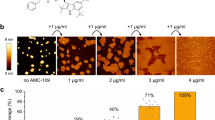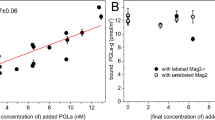Abstract
An increasing amount of information on the action of antimicrobial peptides (AMPs) at the molecular level has not yet been translated into a comprehensive understanding of effects in bacteria. Although some biophysical attributes of AMPs have been correlated with macroscopic features, the physiological relevance of other properties has not yet been addressed. Pertinent and surprising conclusions have therefore been left unstated. Strong membrane-binding and micromolar therapeutic concentrations of AMPs indicate that membrane-bound concentrations may be reached that are higher than intuitively expected, triggering disruptive effects on bacteria.
This is a preview of subscription content, access via your institution
Access options
Subscribe to this journal
Receive 12 print issues and online access
$209.00 per year
only $17.42 per issue
Buy this article
- Purchase on Springer Link
- Instant access to full article PDF
Prices may be subject to local taxes which are calculated during checkout

Similar content being viewed by others
References
Zasloff, M. Antimicrobial peptides of multicellular organisms. Nature 415, 389–395 (2002).
Robinson, W. E. Jr, McDougall, B., Tran, D. & Selsted, M. E. Anti-HIV-1 activity of indolicidin, an antimicrobial peptide from neutrophils. J. Leukoc. Biol. 63, 94–100 (1998).
Albiol Matanic, V. C. & Castilla, V. Antiviral activity of antimicrobial cationic peptides against Junin virus and herpes simplex virus. Int. J. Antimicrob. Agents 23, 382–389 (2004).
Henriques, S. T., Melo, M. N. & Castanho, M. A. Cell-penetrating peptides and antimicrobial peptides: how different are they? Biochem. J. 399, 1–7 (2006).
Bowdish, D. M., Davidson, D. J. & Hancock, R. E. A re-evaluation of the role of host defence peptides in mammalian immunity. Curr. Protein Pept. Sci. 6, 35–51 (2005).
Hoskin, D. W. & Ramamoorthy, A. Studies on anticancer activities of antimicrobial peptides. Biochim. Biophys. Acta 1778, 357–375 (2008).
Hancock, R. E. Peptide antibiotics. Lancet 349, 418–422 (1997).
Yeaman, M. R. & Yount, N. Y. Mechanisms of antimicrobial peptide action and resistance. Pharmacol. Rev. 55, 27–55 (2003).
Brogden, K. A. Antimicrobial peptides: pore formers or metabolic inhibitors in bacteria? Nature Rev. Microbiol. 3, 238–250 (2005).
Baumann, G. & Mueller, P. A molecular model of membrane excitability. J. Supramol. Struct. 2, 538–557 (1974).
Pouny, Y., Rapaport, D., Mor, A., Nicolas, P. & Shai, Y. Interaction of antimicrobial dermaseptin and its fluorescently labeled analogues with phospholipid membranes. Biochemistry 31, 12416–12423 (1992).
Ludtke, S. J. et al. Membrane pores induced by magainin. Biochemistry 35, 13723–13728 (1996).
Leontiadou, H., Mark, A. E. & Marrink, S. J. Antimicrobial peptides in action. J. Am. Chem. Soc. 128, 12156–12161 (2006).
Hsu, J. C. & Yip, C. M. Molecular dynamics simulations of indolicidin association with model lipid bilayers. Biophys. J. 92, L100–L102 (2007).
Sengupta, D., Leontiadou, H., Mark, A. E. & Marrink, S. J. Toroidal pores formed by antimicrobial peptides show significant disorder. Biochim. Biophys. Acta 10, 2308–2317 (2008).
Perron, G. G., Zasloff, M. & Bell, G. Experimental evolution of resistance to an antimicrobial peptide. Proc. Biol. Sci. 273, 251–256 (2006).
Huang, H. W. Molecular mechanism of antimicrobial peptides: the origin of cooperativity. Biochim. Biophys. Acta 1758, 1292–1302 (2006).
Melo, M. N. & Castanho, M. A. Omiganan interaction with bacterial membranes and cell wall models. Assigning a biological role to saturation. Biochim. Biophys. Acta 1768, 1277–1290 (2007).
Pistolesi, S., Pogni, R. & Feix, J. B. Membrane insertion and bilayer perturbation by antimicrobial peptide CM15. Biophys. J. 93, 1651–1660 (2007).
Giacometti, A. et al. In vitro susceptibility tests for cationic peptides: comparison of broth microdilution methods for bacteria that grow aerobically. Antimicrob. Agents Chemother. 44, 1694–1696 (2000).
Staubitz, P. et al. Structure–function relationships in the tryptophan-rich, antimicrobial peptide indolicidin. J. Pept. Sci. 7, 552–564 (2001).
Friedrich, C. L., Moyles, D., Beveridge, T. J. & Hancock, R. E. Antibacterial action of structurally diverse cationic peptides on gram-positive bacteria. Antimicrob. Agents Chemother. 44, 2086–2092 (2000).
Pott, T., Paternostre, M. & Dufourc, E. J. A comparative study of the action of melittin on sphingomyelin and phosphatidylcholine bilayers. Eur. Biophys. J. 27, 237–245 (1998).
Weiss, T. M. et al. Two states of cyclic antimicrobial peptide RTD-1 in lipid bilayers. Biochemistry 41, 10070–10076 (2002).
Wenk, M. R. & Seelig, J. Magainin 2 amide interaction with lipid membranes: calorimetric detection of peptide binding and pore formation. Biochemistry 37, 3909–3916 (1998).
Bastos, M. et al. Energetics and partition of two cecropin–melittin hybrid peptides to model membranes of different composition. Biophys. J. 94, 2128–2141 (2008).
Papo, N. & Shai, Y. Can we predict biological activity of antimicrobial peptides from their interactions with model phospholipid membranes? Peptides 24, 1693–1703 (2003).
Zhang, L., Rozek, A. & Hancock, R. E. Interaction of cationic antimicrobial peptides with model membranes. J. Biol. Chem. 276, 35714–35722 (2001).
Giacometti, A., Cirioni, O., Greganti, G., Quarta, M. & Scalise, G. In vitro activities of membrane-active peptides against gram-positive and gram-negative aerobic bacteria. Antimicrob. Agents Chemother. 42, 3320–3324 (1998).
Gazit, E., Boman, A., Boman, H. G. & Shai, Y. Interaction of the mammalian antibacterial peptide cecropin P1 with phospholipid vesicles. Biochemistry 34, 11479–11488 (1995).
Chiu, S. W., Jakobsson, E., Subramaniam, S. & Scott, H. L. Combined monte carlo and molecular dynamics simulation of fully hydrated dioleyl and palmitoyl-oleyl phosphatidylcholine lipid bilayers. Biophys. J. 77, 2462–2469 (1999).
Haynie, S. L., Crum, G. A. & Doele, B. A. Antimicrobial activities of amphiphilic peptides covalently bonded to a water-insoluble resin. Antimicrob. Agents Chemother. 39, 301–307 (1995).
Andrushchenko, V. V., Aarabi, M. H., Nguyen, L. T., Prenner, E. J. & Vogel, H. J. Thermodynamics of the interactions of tryptophan-rich cathelicidin antimicrobial peptides with model and natural membranes. Biochim. Biophys. Acta 1778, 1004–1014 (2008).
Matsuzaki, K., Fukui, M., Fujii, N. & Miyajima, K. Permeabilization and morphological changes in phosphatidylglycerol bilayers induced by an antimicrobial peptide, tachyplesin I. Colloid Polym. Sci. 271, 901–908 (1993).
Nernst, W. Verteilung eines Stoffes zwischen zwei Lösungsmitteln und zwischen Lösungsmittel und Dampfraum. Z. Phys. Chem. 8, 110–139 (1891).
Santos, N. C., Prieto, M. & Castanho, M. A. Quantifying molecular partition into model systems of biomembranes: an emphasis on optical spectroscopic methods. Biochim. Biophys. Acta 1612, 123–135 (2003).
Tossi, A., Sandri, L. & Giangaspero, A. Amphipathic, α-helical antimicrobial peptides. Biopolymers 55, 4–30 (2000).
Ferre, R. et al. Synergistic effects of the membrane actions of cecropin–melittin antimicrobial hybrid peptide BP100. Biophys. J. (in the press).
Burck, J. et al. Conformation and membrane orientation of amphiphilic helical peptides by OCD. Biophys. J. 95, 3872–3881 (2008).
Pan, Y. L. et al. Characterization of the structure and membrane interaction of the antimicrobial peptides aurein 2.2 and 2.3 from Australian southern bell frogs. Biophys. J. 92, 2854–2864 (2007).
White, S. H. & King, G. I. Molecular packing and area compressibility of lipid bilayers. Proc. Natl Acad. Sci. USA 82, 6532–6536 (1985).
Beschiaschvili, G. & Seelig, J. Melittin binding to mixed phosphatidylglycerol/phosphatidylcholine membranes. Biochemistry 29, 52–58 (1990).
Blondelle, S. E. & Houghten, R. A. Hemolytic and antimicrobial activities of the twenty-four individual omission analogues of melittin. Biochemistry 30, 4671–4678 (1991).
Dathe, M., Nikolenko, H., Meyer, J., Beyermann, M. & Bienert, M. Optimization of the antimicrobial activity of magainin peptides by modification of charge. FEBS Lett. 501, 146–150 (2001).
Maloy, W. L. & Kari, U. P. Structure–activity studies on magainins and other host defense peptides. Biopolymers 37, 105–122 (1995).
Sader, H. S., Fedler, K. A., Rennie, R. P., Stevens, S. & Jones, R. N. Omiganan pentahydrochloride (MBI 226), a topical 12-amino-acid cationic peptide: spectrum of antimicrobial activity and measurements of bactericidal activity. Antimicrob. Agents Chemother. 48, 3112–3118 (2004).
Subbalakshmi, C., Krishnakumari, V., Sitaram, N. & Nagaraj, R. Interaction of indolicidin, a 13-residue peptide rich in tryptophan and proline and its analogues with model membranes. J. Biosci. 23, 9–13 (1998).
Mor, A. & Nicolas, P. The NH2-terminal α-helical domain 1–18 of dermaseptin is responsible for antimicrobial activity. J. Biol. Chem. 269, 1934–1939 (1994).
Acknowledgements
Fundação para a Ciência e a Tecnologia (Portugal) is acknowledged for a grant to M.N. Melo (SFRH/BD/24,778/2005). M.M. Melo is thanked for critical revision of the manuscript.
Author information
Authors and Affiliations
Corresponding author
Ethics declarations
Competing interests
The authors declare no competing financial interests.
Related links
Rights and permissions
About this article
Cite this article
Melo, M., Ferre, R. & Castanho, M. Antimicrobial peptides: linking partition, activity and high membrane-bound concentrations. Nat Rev Microbiol 7, 245–250 (2009). https://doi.org/10.1038/nrmicro2095
Issue Date:
DOI: https://doi.org/10.1038/nrmicro2095
This article is cited by
-
Synthetic peptide branched polymers for antibacterial and biomedical applications
Nature Reviews Bioengineering (2024)
-
Interactions of human β-defensin 28 with solid supports mimicking bacterial and mammalian cell membranes
Emergent Materials (2024)
-
The impact of N-glycosylation on the properties of the antimicrobial peptide LL-III
Scientific Reports (2023)
-
Lateral membrane organization as target of an antimicrobial peptidomimetic compound
Nature Communications (2023)
-
Host defense peptide-mimicking peptide polymer-based antibacterial hydrogel enables efficient healing of MRSA-infected wounds
Science China Chemistry (2023)



